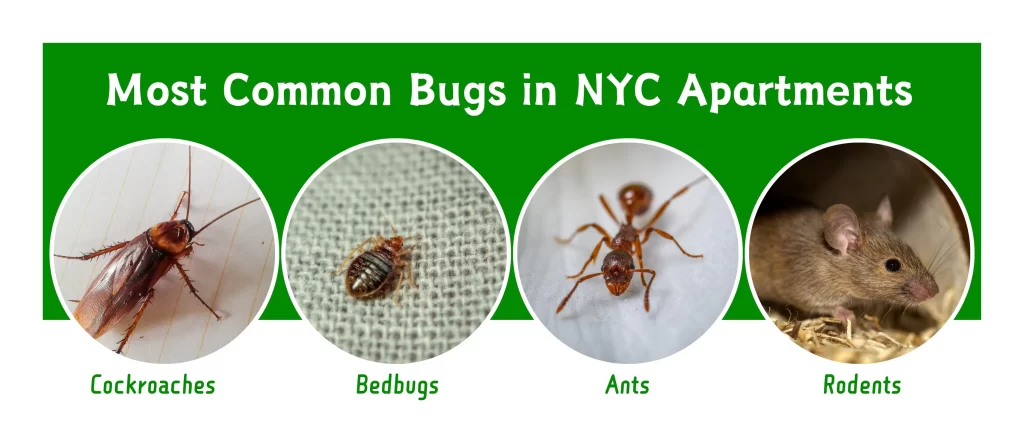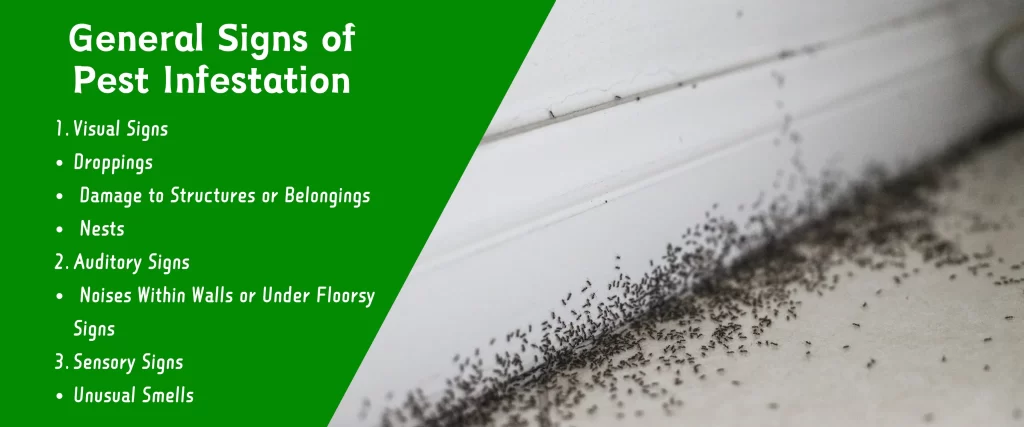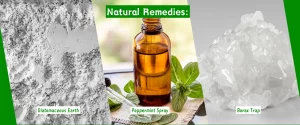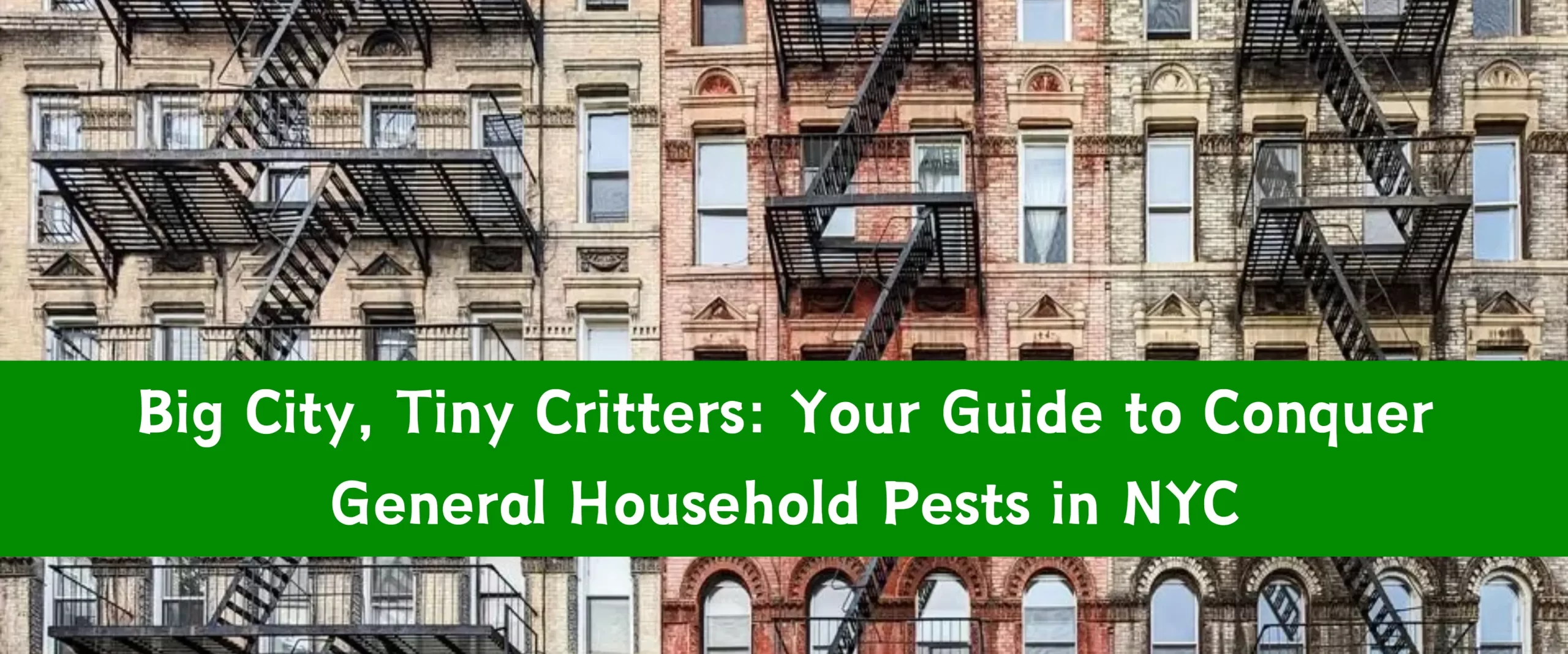Big City, Tiny Critters: Your Guide to Conquer General Household Pests in NYC
Living in a vibrant metropolis like New York City comes with undeniable perks. But alongside the hustle and bustle can creep in some unwelcome guests – household pests. From scuttling roaches to midnight snacking mice, these tiny intruders can disrupt your peace of mind and even pose health risks.
Don’t let these creepy crawlies take over your apartment! This guide equips you with the knowledge and strategies to keep your NYC home pest-free.
Most Common Bugs in NYC Apartments

Cockroaches
Cockroaches are one of the most notorious pests in NYC. They thrive in warm, moist environments and are typically found in kitchens and bathrooms. Common cockroach species include the American cockroach, German cockroach, and Oriental cockroach. They can contaminate food, trigger allergies, and spread diseases.
Bed Bugs
Bed bugs are small, reddish-brown insects that feed on human blood. They are most active at night and can be found in mattresses, bed frames, and furniture. Bed bugs are known for their itchy bites and can be difficult to eradicate once they infest a home.
Ants
Ants are common in NYC apartments, particularly in the warmer months. Species like the pavement ant and the odorous house ant are often seen. They enter homes in search of food and can be a persistent problem if not addressed promptly.
Rodents
Rodents, including mice and rats, are a significant concern in NYC. They can cause structural damage, contaminate food, and spread diseases. Rodents are adept at finding entry points into buildings and can reproduce quickly, making infestations challenging to control.
General Signs of Pest Infestation
Visual Signs
- Droppings: Pest droppings are a clear sign of an infestation. The size and shape of droppings can help identify the pest.
- Damage to Structures or Belongings: Gnaw marks, holes in walls, chewed wires, and damaged furniture are indicative of pest activity.
- Nests: Rodents and insects often build nests in hidden areas, such as inside walls, attics, or basements.

Auditory Signs
- Noises Within Walls or Under Floors: Scratching, squeaking, or scurrying sounds can indicate the presence of rodents or larger insects moving around.
Sensory Signs
- Unusual Smells: A strong, musty odor can be a sign of a pest infestation, particularly from rodents or cockroaches.
Battling Back: Prevention and Management Strategies
Don’t wait for a full-blown infestation! Here’s a two-pronged approach to keep pests at bay:
Natural Allies: Indoor Plants for Insect Repellent

Nature offers a helping hand! Certain plants have properties that deter pests. Consider incorporating these into your décor:
- Basil: The fragrant leaves repel flies and mosquitoes.
- Lavender: The scent discourages moths and some flies.
- Mint: The strong aroma repels ants and some other crawling insects.
Best Practices for Incorporating These Plants into Your Home
Place these plants in areas where pests are likely to enter, such as near windows, doorways, and kitchens. Regularly prune and care for the plants to ensure they remain healthy and effective.
Placement Strategies for Maximum Effectiveness
Strategically position the plants in pest-prone areas. For instance, place lavender near sleeping areas to ward off mosquitoes, and basil in the kitchen to keep flies away.
A Multi-Faceted Approach: Natural and Chemical Solutions
Natural Remedies:

For mild infestations, try these DIY solutions:
- Diatomaceous Earth: This powder dehydrates insects with its abrasive texture.
- Peppermint Spray: Mix peppermint oil with water to deter ants and roaches.
- Borax Traps: Combine borax with sugar to create an attractive yet fatal bait for ants and roaches.
Chemical Treatments:
For severe infestations or persistent problems, consider professional help. A licensed pest control company can assess the situation and recommend the most effective treatment plan, while ensuring safety and proper application of chemicals.
Keeping Your Home a Pest-Free Paradise
Even after tackling an infestation, vigilance is key to prevent future problems:
- Routine Inspections: Regularly check for signs of pests, especially in high-risk areas like kitchens, bathrooms, and behind furniture.
- Long-Term Strategies:
- Seal cracks and crevices in walls and around pipes.
- Store food in airtight containers.
- Empty trash cans regularly and keep them clean.
- Address any moisture issues like leaky faucets or condensation.
By following these tips and creating a pest-unfriendly environment, you can enjoy a peaceful and healthy home, free from unwanted creepy crawlies.
Conclusion
Effective pest management is essential for a healthy, comfortable home. By being proactive and utilizing natural methods like indoor plants, you can prevent and control pest infestations. Regular maintenance and early detection are key to maintaining a pest-free environment.
FAQs
Commonly Asked Questions About Pest Infestations and Their Management
- What should I do if I find droppings in my home? Identify the type of pest and clean the area thoroughly. Set traps or use natural remedies and consider calling a professional if the problem persists.
- How can I prevent bed bugs when traveling? Inspect hotel rooms for signs of bed bugs, keep luggage off the floor, and wash clothing immediately upon returning home.
- Are natural pest control methods effective? Yes, many natural methods can be highly effective, especially when combined with good housekeeping practices and regular maintenance.
- When should I call a professional pest control service? Call a professional if you have a severe infestation, repeated issues, or if natural and DIY methods are not working.

